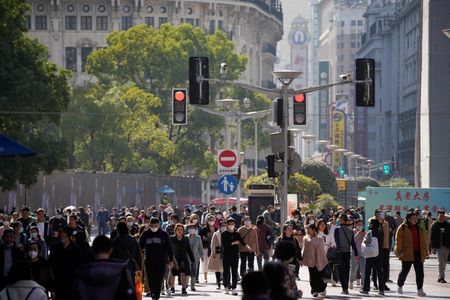By Winni Zhou and Tom Westbrook
SHANGHAI/SINGAPORE (Reuters) – China’s increasingly urgent efforts to tip its mountain of savings into the economy are running up against depositors shy of all but the safest investments, in the latest sign that weak confidence is holding back post-pandemic spending and growth.
The latest move — prodding the “big four” state banks to cut top deposit rates this month — seems only to have extended a rush into other deposit products and government debt, suggesting caution runs so deep it will be difficult to shift.
Television pictures this week showed early-morning queues at banks in Beijing for buying treasury savings bonds, while newspapers carried stories of young investors riding trains and buses to far-flung branches seeking the highest deposit rates.
Bankers told Reuters they ran out of bonds soon after opening. Government debt yields – which fall when prices rise – dropped to levels unseen since November, when the economy was still being throttled by China’s zero-tolerance policies to combat COVID-19.
The trend defies expectations that savings would pour back into stocks and consumption once virus controls were lifted, and as term deposits have swelled that looks even more unlikely to happen.
“The 8 trillion yuan surge in new household deposits in 2022 triggered some bullish market views that this … would lead to a massive release of post-pandemic pent-up demand,” said Ting Lu, chief China economist at Nomura.
“However, new household deposits rose further,” he said.
“The real barrier of China’s post-COVID recovery is not about high funding costs or a lack of liquidity. In our view, it is the reduced confidence of the private and household sectors … and low velocity of money.”
Total yuan deposits stood at a near-record 274 trillion yuan ($40 trillion) at the end of April – dwarfing the market capitalisation of the mainland stock market, which is 84 trillion yuan, and gross domestic product, at 121 trillion yuan.
Personal deposits are also at a record and PBOC data showed fixed-term deposits, which can offer as little as 1%, are growing particularly fast.
They rose 8.9% from January to March at large-sized banks to 25 trillion yuan, and were up 11.1% at smaller lenders, and Goldman Sachs analysts said that implies households are unlikely to spend money they lock away in timed accounts.
SAVING UP
The trigger for the surge in savings is unclear, but with the property market wobbly in the wake of a crackdown on over-leveraged developers and momentum ebbing from the stockmarket, depositors say they are willing to sacrifice returns for safety.
“These certificate of deposits guarantee principal, so they offer stable returns,” said one fixed-term depositor in her 50s, who gave her surname as Wang and said she was undeterred by falling interest rates.
“I will continue to save most of my money,” she said. “I don’t think stocks will perform well this year.”
China has historically had high savings rates as a proportion of GDP – the highest by far among large economies according to the World Bank.
It is not inherently problematic, but when combined with capital controls preventing investment abroad and below-expectations loan growth at home, it reflects weak domestic consumption and is a sign that money is not easily finding its way to productive enterprises.
Official data this week showing soft imports and deepening deflation in producer prices underscored the challenge. Benchmark 10-year Chinese government bond yields fell to a six-month low of 2.694% on Thursday.
“The problem for consumption recovery is a loss of confidence due to the now scrapped zero-COVID policy and the property market problem,” said Chi Lo, senior investment strategist at BNP Paribas Asset Management in Hong Kong.
“Although these two biggest drags on the economy have been addressed, confidence will only recover slowly – confidence would not come back like switching an on/off switch.”
($1 = 6.9121 Chinese yuan renminbi)
(Editing by Simon Cameron-Moore)





